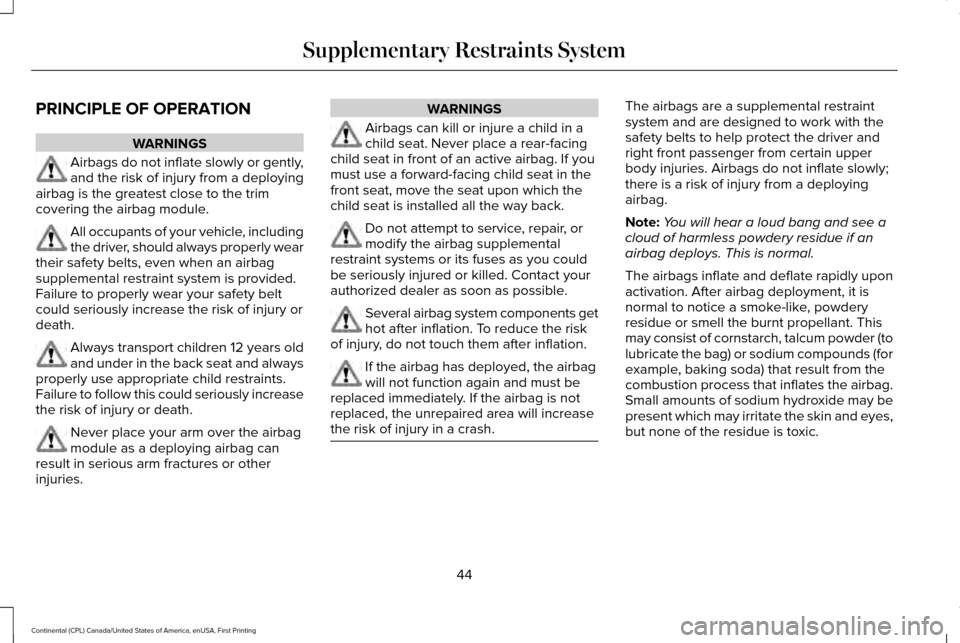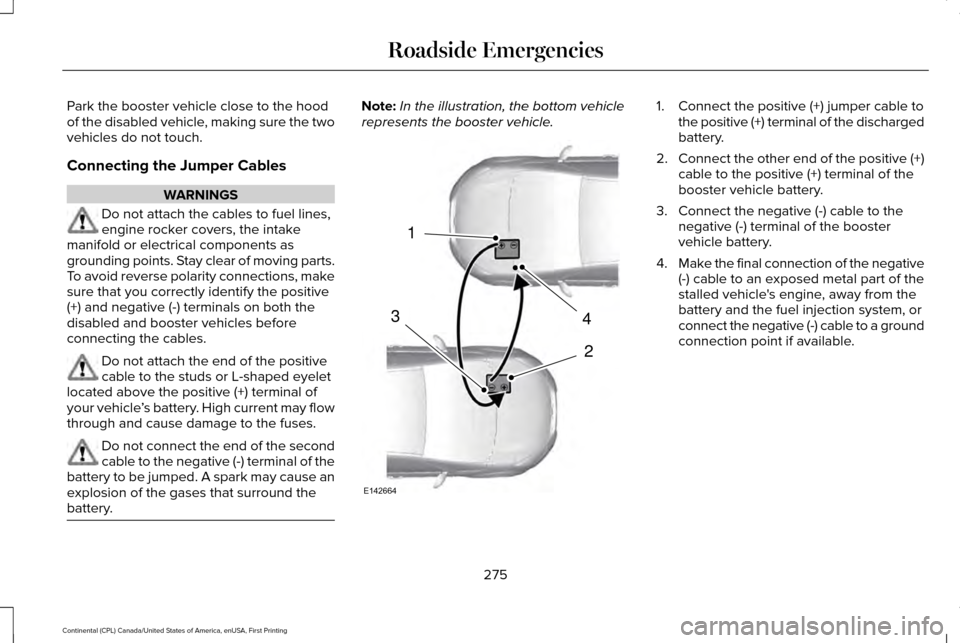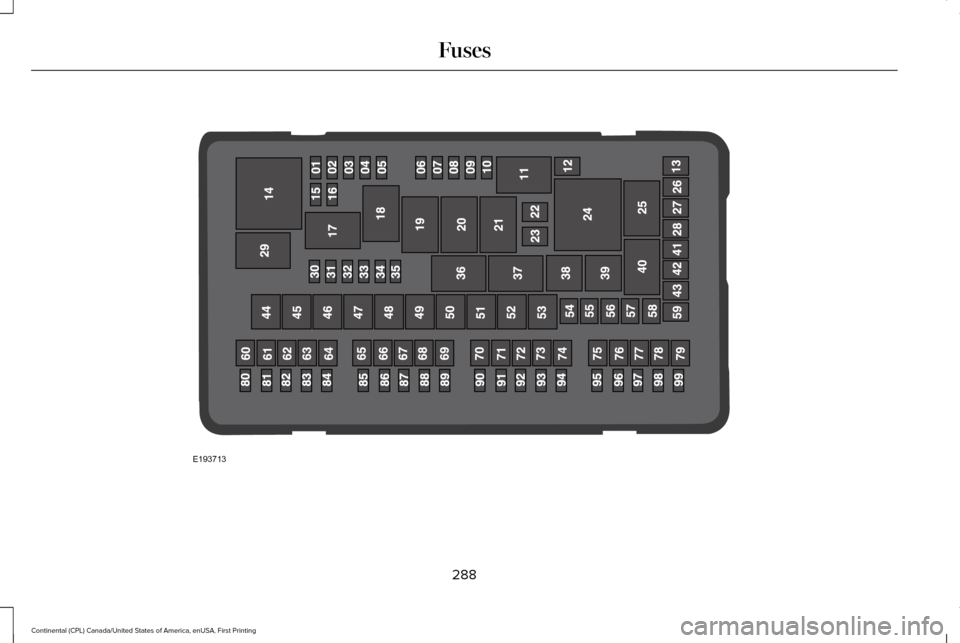2017 LINCOLN CONTINENTAL fuses
[x] Cancel search: fusesPage 7 of 584

Steering...........................................................251
Pre-Collision Assist......................................253
Drive Control
.................................................256
Load Carrying
Load Limit.......................................................258
Towing
Towing a Trailer
.............................................263
Recommended Towing Weights..............264
Essential Towing Checks
...........................265
Towing the Vehicle on Four Wheels........267
Driving Hints
Breaking-In....................................................269
Economical Driving
......................................269
Driving Through Water...............................269
Floor Mats
......................................................270
Roadside Emergencies
Roadside Assistance
...................................272
Hazard Warning Flashers...........................273
Fuel Shutoff
....................................................273 Jump Starting the Vehicle..........................274
Post-Crash Alert System.............................277
Transporting the Vehicle.............................277
Customer Assistance
Getting the Services You Need
................279
In California (U.S. Only)
...............................280
The Better Business Bureau (BBB) Auto Line Program (U.S. Only).........................281
Utilizing the Mediation/Arbitration Program (Canada Only)
...........................................282
Getting Assistance Outside the U.S. and Canada.......................................................283
Ordering Additional Owner's Literature
....................................................284
Reporting Safety Defects (U.S. Only)......285
Reporting Safety Defects (Canada Only)............................................................285
Fuses
Fuse Specification Chart............................287
Changing a Fuse..........................................303 Maintenance
General Information
.....................................306
Opening and Closing the Hood...............306
Under Hood Overview - 2.7L EcoBoost™/ 3.7L..............................................................308
Under Hood Overview - 3.0L EcoBoost™...................................................310
Engine Oil Dipstick - 2.7L EcoBoost™.......312
Engine Oil Dipstick - 3.0L EcoBoost™.......312
Engine Oil Dipstick - 3.7L............................312
Engine Oil Check...........................................312
Oil Change Indicator Reset.........................314
Engine Coolant Check.................................314
Automatic Transmission Fluid Check
.......319
Brake Fluid Check........................................323
Washer Fluid Check.....................................323
Fuel Filter
........................................................324
Changing the 12V Battery
..........................324
Checking the Wiper Blades.......................325
Changing the Wiper Blades
......................325
Adjusting the Headlamps
..........................326
Changing a Bulb
...........................................327
Bulb Specification Chart
.............................328
4
Continental (CPL) Canada/United States of America, enUSA, First Printing Table of Contents
Page 47 of 584

PRINCIPLE OF OPERATION
WARNINGS
Airbags do not inflate slowly or gently,
and the risk of injury from a deploying
airbag is the greatest close to the trim
covering the airbag module. All occupants of your vehicle, including
the driver, should always properly wear
their safety belts, even when an airbag
supplemental restraint system is provided.
Failure to properly wear your safety belt
could seriously increase the risk of injury or
death. Always transport children 12 years old
and under in the back seat and always
properly use appropriate child restraints.
Failure to follow this could seriously increase
the risk of injury or death. Never place your arm over the airbag
module as a deploying airbag can
result in serious arm fractures or other
injuries. WARNINGS
Airbags can kill or injure a child in a
child seat. Never place a rear-facing
child seat in front of an active airbag. If you
must use a forward-facing child seat in the
front seat, move the seat upon which the
child seat is installed all the way back. Do not attempt to service, repair, or
modify the airbag supplemental
restraint systems or its fuses as you could
be seriously injured or killed. Contact your
authorized dealer as soon as possible. Several airbag system components get
hot after inflation. To reduce the risk
of injury, do not touch them after inflation. If the airbag has deployed, the airbag
will not function again and must be
replaced immediately. If the airbag is not
replaced, the unrepaired area will increase
the risk of injury in a crash. The airbags are a supplemental restraint
system and are designed to work with the
safety belts to help protect the driver and
right front passenger from certain upper
body injuries. Airbags do not inflate slowly;
there is a risk of injury from a deploying
airbag.
Note:
You will hear a loud bang and see a
cloud of harmless powdery residue if an
airbag deploys. This is normal.
The airbags inflate and deflate rapidly upon
activation. After airbag deployment, it is
normal to notice a smoke-like, powdery
residue or smell the burnt propellant. This
may consist of cornstarch, talcum powder (to
lubricate the bag) or sodium compounds (for
example, baking soda) that result from the
combustion process that inflates the airbag.
Small amounts of sodium hydroxide may be
present which may irritate the skin and eyes,
but none of the residue is toxic.
44
Continental (CPL) Canada/United States of America, enUSA, First Printing Supplementary Restraints System
Page 52 of 584

Make sure the front passenger
sensing system is operating
properly. See Crash Sensors and
Airbag Indicator (page 52).
If the airbag readiness light is lit, do the
following:
The driver and adult passengers should
check for objects lodged underneath the
front passenger seat or cargo interfering with
the seat.
If objects are lodged or cargo is interfering
with the seat, please take the following steps
to remove the obstruction:
• Pull your vehicle over.
• Turn your vehicle off.
• Driver or adult passengers should check
for any objects lodged underneath the
front passenger seat or cargo interfering
with the seat.
• Remove the obstruction(s) (if found).
• Restart your vehicle. •
Wait at least two minutes and verify that
the airbag readiness light in the
instrument cluster is no longer
illuminated.
• If the airbag readiness light in the
instrument cluster remains illuminated,
this may or may not be a problem due to
the front passenger sensing system.
Do not attempt to repair or service the
system. Take your vehicle immediately to an
authorized dealer.
If it is necessary to modify an advanced front
airbag system to accommodate a person
with disabilities, contact the Ford Customer
Relationship Center.
SIDE AIRBAGS WARNINGS
Do not place objects or mount
equipment on or near the airbag cover,
on the side of the seatbacks (of the front
seats), or in front seat areas that may come
into contact with a deploying airbag. Failure
to follow these instructions may increase the
risk of personal injury in the event of a crash. WARNINGS
Do not use accessory seat covers. The
use of accessory seat covers may
prevent the deployment of the side airbags
and increase the risk of injury in an accident. Do not lean your head on the door. The
side airbag could injure you as it
deploys from the side of the seatback. Do not attempt to service, repair, or
modify the airbag, its fuses or the seat
cover on a seat containing an airbag as you
could be seriously injured or killed. Contact
your authorized dealer as soon as possible. If the side airbag has deployed, the
airbag will not function again. The side
airbag system (including the seat) must be
inspected and serviced by an authorized
dealer. If the airbag is not replaced, the
unrepaired area will increase the risk of injury
in a crash. 49
Continental (CPL) Canada/United States of America, enUSA, First Printing Supplementary Restraints System
Page 54 of 584

SAFETY CANOPY™
WARNINGS
Do not place objects or mount
equipment on or near the headliner at
the siderail that may come into contact with
a deploying curtain airbag. Failure to follow
these instructions may increase the risk of
personal injury in the event of a crash. Do not lean your head on the door. The
curtain airbag could injure you as it
deploys from the headliner. Do not attempt to service, repair, or
modify the curtain airbags, its fuses,
the A, B, or C pillar trim, or the headliner on
a vehicle containing curtain airbags as you
could be seriously injured or killed. Contact
your authorized dealer as soon as possible. All occupants of your vehicle including
the driver should always wear their
safety belts even when an airbag
supplemental restraint system and curtain
airbag is provided. Failure to properly wear
your safety belt could seriously increase the
risk of injury or death. WARNINGS
To reduce risk of injury, do not obstruct
or place objects in the deployment
path of the curtain airbag. If the curtain airbags have deployed,
the curtain airbags will not function
again. The curtain airbags (including the A,
B and C pillar trim and headliner) must be
inspected and serviced by an authorized
dealer. If the curtain airbag is not replaced,
the unrepaired area will increase the risk of
injury in a crash. The Safety Canopy will deploy during
significant side crashes or when a certain
likelihood of a rollover event is detected by
the rollover sensor. The Safety Canopy is
mounted to the roof side-rail sheet metal,
behind the headliner, above each row of
seats. In certain sideways crashes or rollover
events, the Safety Canopy will be activated,
regardless of which seats are occupied. The
Safety Canopy is designed to inflate between
the side window area and occupants to
further enhance protection provided in side
impact crashes and rollover events. The system consists of the following:
•
Safety canopy curtain airbags located
above the trim panels over the front and
rear side windows identified by a label
or wording on the headliner or roof-pillar
trim.
• A flexible headliner which opens above
the side doors to allow air curtain
deployment · Crash sensors and monitoring
system with a readiness indicator.
See Crash Sensors and Airbag
Indicator (page 52).
51
Continental (CPL) Canada/United States of America, enUSA, First Printing Supplementary Restraints SystemE75004
Page 266 of 584

TOWING A TRAILER
WARNINGS
Do not exceed the GVWR or the
GAWR specified on the certification
label. Towing trailers beyond the
maximum recommended gross
trailer weight exceeds the limit of your
vehicle and could result in engine
damage, transmission damage,
structural damage, loss of vehicle
control, vehicle rollover and personal
injury. Note:
There may be electrical items
such as fuses or relays that can affect
trailer towing operation. See Fuses
(page 287). The load capacity of your vehicle is
designated by weight not volume. You
may not necessarily be able to use all
available space when loading your
vehicle or trailer.
Towing a trailer places extra load on the
engine, transmission, axle, brakes, tires,
and suspension. Inspect these
components before, during and after
towing.
Load Placement
To help minimize how trailer movement
affects the vehicle when driving:
•
Load the heaviest items closest to
the trailer floor.
• Load the heaviest items in the center
of the left and right side trailer tires. •
Load the heaviest items above the
trailer axles or just slightly forward
toward the trailer tongue. Do not
allow the final trailer tongue weight
to go above or below 10-15% of the
loaded trailer weight.
• Select a ball mount with the correct
rise or drop. When both the loaded
vehicle and trailer are connected, the
trailer frame should be level, or
slightly angled down toward the
vehicle, when viewed from the side.
When driving with a trailer or payload, a
slight takeoff vibration or shudder may
be present due to the increased payload
weight. Additional information regarding
proper trailer loading and setting your
vehicle up for towing is located in the
Load Carrying chapter.
See Load Limit
(page 258).
You can also find information in the
RV
& Trailer Towing Guide available at your
authorized dealer, or online.
263
Continental (CPL) Canada/United States of America, enUSA, First Printing Towing
Page 278 of 584

Park the booster vehicle close to the hood
of the disabled vehicle, making sure the two
vehicles do not touch.
Connecting the Jumper Cables
WARNINGS
Do not attach the cables to fuel lines,
engine rocker covers, the intake
manifold or electrical components as
grounding points. Stay clear of moving parts.
To avoid reverse polarity connections, make
sure that you correctly identify the positive
(+) and negative (-) terminals on both the
disabled and booster vehicles before
connecting the cables. Do not attach the end of the positive
cable to the studs or L-shaped eyelet
located above the positive (+) terminal of
your vehicle ’s battery. High current may flow
through and cause damage to the fuses. Do not connect the end of the second
cable to the negative (-) terminal of the
battery to be jumped. A spark may cause an
explosion of the gases that surround the
battery. Note:
In the illustration, the bottom vehicle
represents the booster vehicle. 1. Connect the positive (+) jumper cable to
the positive (+) terminal of the discharged
battery.
2. Connect the other end of the positive (+)
cable to the positive (+) terminal of the
booster vehicle battery.
3. Connect the negative (-) cable to the negative (-) terminal of the booster
vehicle battery.
4. Make the final connection of the negative
(-) cable to an exposed metal part of the
stalled vehicle's engine, away from the
battery and the fuel injection system, or
connect the negative (-) cable to a ground
connection point if available.
275
Continental (CPL) Canada/United States of America, enUSA, First Printing Roadside Emergencies4
2
1
3
E142664
Page 290 of 584

FUSE SPECIFICATION CHART
Power Distribution Box
WARNINGS
Always disconnect the battery before
servicing high-current fuses. WARNINGS
To reduce risk of electrical shock,
always replace the cover to the power
distribution box before reconnecting the
battery or refilling fluid reservoirs. The power distribution box is located in the
engine compartment. It has high-current
fuses that protect your vehicle's main
electrical systems from overloads.
If the battery has been disconnected and
reconnected, some features will need to be
reset. See Changing the 12V Battery (page
324).
287
Continental (CPL) Canada/United States of America, enUSA, First Printing Fuses
Page 291 of 584

288
Continental (CPL) Canada/United States of America, enUSA, First Printing FusesE193713